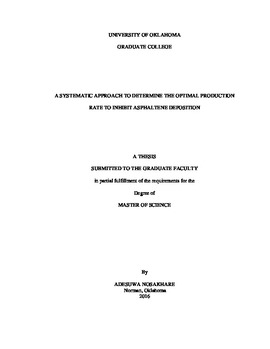| dc.description.abstract | This thesis utilizes a systematic mathematical model, scaling analysis, to quantify the effect of production rate on asphaltene deposition, using a set of uniquely described mathematical equations modeled for the deposition process. Investigations to mitigate the effects of asphaltene deposition in both the well bore and porous media have recently focused on the first stage of formation; precipitation. Although the precipitation of asphaltene is necessary, it is not sufficient to guarantee its deposition; which poses the major problem for oil production. Quantification of these effects provides clarity on which individual factors create a significant impact on deposition. Results are compared to previously published, experimentally determined, significant factors for various asphaltene formation scenarios.
The study employs the ‘order of one’ scaling analysis method to identify the dimensionless groups that are specific to asphaltene deposition near the well bore and in production tubing. The describing equation includes the overall mass and momentum balance equations, precipitation and deposition equations and the reduction models for porosity and permeability. The dimensionless groups obtained are reduced to eradicate independence and the magnitudes of the individual variables are utilized to assess possible simplifying approximations. Assessment is based on the order of one scaling to determine the factors with greater magnitudes and identify their effects on the overall model. Governing equations, initial, boundary and auxiliary conditions are provided and described in detail to enable effective replication.
The minimum parametric representation of the describing equations are obtained and presented as twenty one dimensionless groups. These dimensionless groups emphasize the importance of the concentration of asphaltene precipitate to the overall deposition rate. Results show that the deposition rate decreases significantly with a decrease in reservoir pressure, this is an important finding for secondary recovery. Optimum conditions, beyond which a significant increase in asphaltene deposition occurs, was determined at different production flow rates. Outcomes were correlated to experimental work done including the effect of CO2 flooding on asphaltene deposition.
The main contribution of this work is to identify a set of dimensionless groups that aid retardation of the asphaltene deposition. The results obtained provide a template for the efficient design of experiments related to Asphaltene. In practice, the knowledge from this work will improve the effectiveness of flow assurance designs by ensuring that priority is placed on parameters with the most impact on asphaltene deposition in producing wells; saving time and costs associated with speculation. | en_US |
